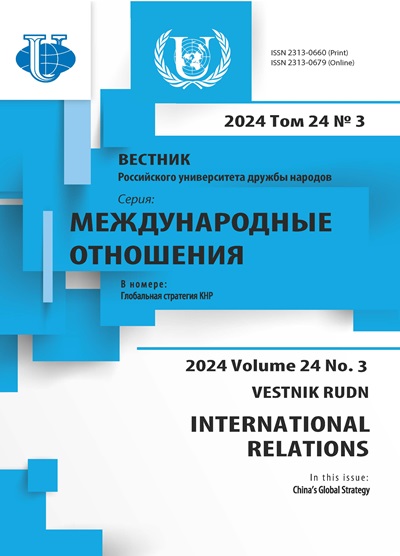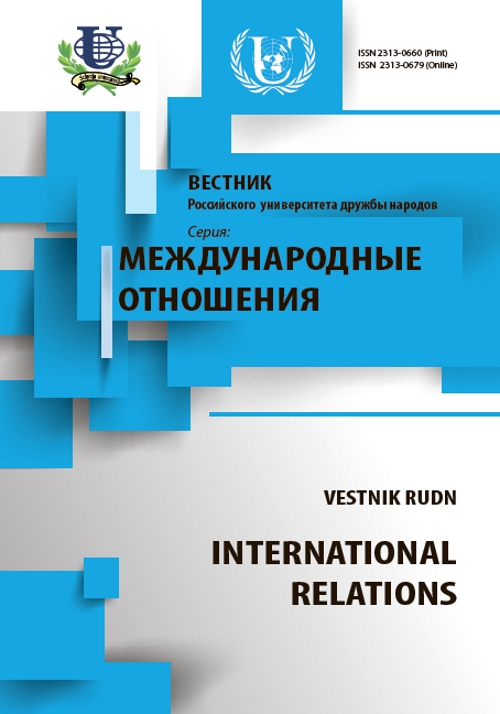Япония и Китай в Юго-Восточной Азии: политическое измерение
- Авторы: Мартынова Е.С.1
-
Учреждения:
- Национальный исследовательский университет Высшая школа экономики
- Выпуск: № 1 (2013)
- Страницы: 63-73
- Раздел: Статьи
- URL: https://journals.rudn.ru/international-relations/article/view/10356
- Дата ретрагирования: 07.09.2018
- Причина ретрагирования:
Ретракция публикации обусловлена выявлением дублирования публикации: Мартынова Е.С. Япония и Китай в Юго-Восточной Азии: политическое измерение // Вестник Томского государственного университета. 2013. № 368. С. 82–86; Мартынова Е.С. Япония и Китай в Юго-Восточной Азии: политическое измерение // Россия и АТР. 2013. №1. С. 148–158.
Статья ретрагируется (отзывается из печати) главным редактором с согласия издателя.
Цитировать
Полный текст

Аннотация
В статье рассматривается политика Японии и Китая в Юго-Восточной Азии на современном этапе. Анализируется процесс становления и развития диалогового формата «АСЕАН+3», который объединяет десять членов АСЕАН и три государства Северо-Восточной Азии — Японию, Китай и Южную Корею. «АСЕАН+3» может послужить катализатором для процессов экономической и политической интеграции в Восточной Азии. Соперничество Китая и Японии является главным фактором, сдерживающим развитие интеграции. Проведенный анализ позволяет сделать вывод о том, что региональным лидером в Восточной и Юго-Восточной Азии в данный момент является Китай.
Ключевые слова
Об авторах
Елена Святославовна Мартынова
Национальный исследовательский университет Высшая школа экономики
Email: emartynova@hse.ru; nefriema@list.ru
Кафедра мировой политики
Список литературы
- Мазырин В.М. Развитие торгово-экономических отношений АСЕАН с Китаем // АСЕАН в начале XXI века. Актуальные проблемы и перспективы. — М., 2010. — С. 164—189.
- Манежев С.А. Экономические отношения КНР со странами Юго-Восточной Азии. — М., 1980. — С. 62.
- Михеев В.В. Китай и Япония на фоне глобальных тенденций // Мировая экономика и международные отношения. — 2007. — № 4. — С. 50—60.
- Мосяков Д.В. Новые реалии в интеграционных процессах в Восточной и Юго-Восточной Азии и их возможные последствия // Юго-Восточная Азия в 2002 г. актуальные проблемы развития. — М., 2003. — С. 8—16.
- Саплин-Силановицкий Ю. КНР — Япония. Кто будет лидером в Восточной Азии? // Азия и Африка сегодня. — 2007. — № 2 (595). — С. 25—28.
- Aggarwal Vinod K. and Min Gyo Koo. Northeast Asia’s Economic and Security Regionalism: Withering or Blossoming? // Cross Currents: Regionalism and Nationalism in Northeast Asia / Gi-Wook Shin and Daniel C. Sneider, eds., Walter H Shorenstein. — Asia Pacific Research Center at Stanford University, 2007. — P. 51.
- Arifin S., Dian Ediana Rae and Charles P.R. Joseph Kerja sama perdagangan internasional: peluang dan tantangan bagi Indonesia. — Elex Media Komputindo, 2007. — h. 226.
- Beeson M. Rethinking regionalism: Europe and East Asia in comparative historical perspective // Journal of European Public Policy. — 2005. — 12:6. — P. 969—985.
- Berger M. The battle for Asia: from decolonization to globalization, Asia’s transformations Critical Asian scholarship. — Routledge, 2004. — P. 160.
- Chalermpalanupap T. An East Asian FTA: a new frontier of economic cooperation in East Asia // East Asian economic regionalism: feasibilities and challenges / ed. Ahn, Choong Yong, Baldwin, Richard E., Cheong, Inkyo. — Springer, 2005. — P. 57—74.
- Chu Cheow E.T. ASEAN+3: The roles of ASEAN and China // ASEAN-China relations: realities and prospects / ed. Saw Swee-Hock, Sheng Lijun, Chin Kin Wah. — Institute of Southeast Asian Studies, 2005, Singapore. — P. 49—68.
- Dent С.М. China, Japan and regional leadership in East Asia. — Edward Elgar Publishing, 2008. — P. 10.
- Dosch J. The post-Cold War development of regionalism in East Asia // Regionalism in East Asia: paradigm shifting? / ed. Fu-Kuo Liu and Philippe Régnier. — Routledge, 2003. — P. 30—51.
- Framework Agreement on Comprehensive Economic Co-Operation Between ASEAN and the People’s Republic of China, Phnom Penh, 4 November 2002 // The ASEAN official web site. URL: http://www.aseansec.org/13196.htm (дата обращения: 15.02.2012).
- Fukushima A. The changing balance of power in the international order in the context of globalization: the case of Japan // War, Peace and Hegemony in a Globalized World: The changing balance of power in the twenty-first century / ed. Chandra Chari. — Routledge, 2008. — P. 149—163.
- Higgott R. and Timmermann M. Institutionalizing East Asia: Learning lessons from Europe on regionalism, regionalization, identity and leadership // Institutionalizing Northeast Asia: Regional Steps Towards Global Governance / ed. Timmermann M., Tsuchiyama J. — United Nations University Press, 2008.
- Instrument of accession to the Treaty of Amity and Cooperation in Southeast Asia, 8 October 2003 // The ASEAN official web site. URL: http://www.aseansec.org/15271.htm (дата обращения: 15.02.2012).
- Jimbo K. An Emerging East Asian Community? The Political Process of Regionalism in East Asia // An East Asian community and the United States / Ralph A. Cossa and Akihiko Tanaka eds., Center for Strategic and International Studies — Washington D.C., 2007. — P. 14—42.
- Lincoln E.J. East Asian Economic Regionalism. — Brookings Institution Press, 2004. — P. 247—248.
- Martin J.D., Smith M.L R. Making Process, Not Progress. ASEAN and the Evolving East Asian Regional Order // International Security. — 2007. — Vol. 32. — No. 1 (Summer 2007). — P. 148—184.
- Masyarakat Ekonomi ASEAN (MEA), 2015: memperkuat sinergi ASEAN di tengah kompetisi global / ed. R. Winantyo, Tim Bank Indonesia, Sjamsul Arifin, Rizal A. Djaafara, Aida S. Budiman. — Elex Media Komputindo, 2008. — H. 260
- Paltiel J. China’s Regionalization Policies: Illiberal Internationalism or Neo-Mencian Benevolence? // China and the global politics of regionalization / ed. Emilian Kavalski. — Ashgate Publishing Limited, 2009. — P. 47—63.
- Pempel T.J. Remapping East Asia: the construction of a region, Cornell studies in political economy. — Cornell University Press, 2005. — P. 261.
- Plan of Action to Implement the Joint Declaration on ASEAN-China Strategic Partnership for Peace and Prosperity // The ASEAN official web site. URL: http://www.aseansec.org/ 16805.htm (дата обращения: 15.02.2012)
- Ravenhill J. The “new East Asian regionalism”: A political domino effect // Review of International Political Economy. — 2010. — 17: 2. — P. 178—208.
- Severino R. ASEAN. — Institute of Southeast Asian Studies, 2008. — P. 96.
- Stubbs R. ASEAN Plus Three: Emerging East Asian Regionalism?// Asian Survey. — 2002. — 42:3. — P. 440—455.
- Tangkitvanich Somkiat, Nikomborirak Deunden. The impact of External Changes and Japan’s Role in Industrializing Thailand // Asian Development Experience. Vol. 3: Regional Cooperation in Asia / ed. Ryokichi Hirono. — Institute of Southeast Asian Studies, 2003. — P. 50—73.
- Terada T. The birth and growth of ASEAN+3 // Regional Integration in East Asia and Europe: convergence or divergence? / ed. Bertrand Fort and Douglas Webber. — Routledge, 2006. — P. 218—237.
- The 23rd ASEAN Economic Ministers Meeting, Malaysia, 7—8 October 1991 // The ASEAN official web site. URL: http://www.aseansec.org/6126.htm (дата обращения: 15.02.2012)
- Thomas N. China’s regional governance: developing norms and institutions // Governance and regionalism in Asia / ed. Nicholas Thomas. — Routledge, 2009. — P. 116—146.
- Webber D. The regional integration that didn't happen: cooperation without integration in early twenty-first century East Asia// The Pacific Review. — 2010. — 23:3. — P. 313—333.
- Yamazawa Ippei, Kinoshita Toshihiko, Kwan C.H. Japan and East Asia: How Do We Meet the Globalization Challenge Together? // A New East Asia — Toward a Regional Community / ed. Kazuko Mori and Kenichiro Hirano. — National University of Singapore, 2007. — P. 68—100.
- Yugang Chen. Community Building or Rebalancing? China and the United States in Southeast Asia // China and East Asian strategic dynamics: the shaping of a new regional order / ed. Mingjiang Li and Dongmin Lee. — Lexington Books, 2011. — P. 3—19.
- Yunling Zh. China and Asian regionalism. — World Scientific, 2010. — P. 12.











